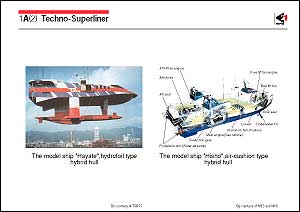Rising production and consumption
on the global scale have created the need for higher-speed mass
transportation of raw materials and products. Ships have the
advantage of transporting large quantities of cargo in each voyage,
but are much slower than land and air transport.
In order to realize a new type of marine transportation, the
major Japanese shipbuilding companies are cooperating in a joint
project to develop a super-high-speed cargo vessel called the
"Techno-Superliner". The photographs show two prototypes
of the ship, the hydrofoil type and air-cushion type, chosen
for testing them on the high sea. When completed, the Techno-Superliner
(1,000 DWT) is expected to travel from Japan to Southeast Asian
countries in one or two days at a target speed of 100 km/h.
Almost all conventional ships support the dead weight of the
vessel and load with buoyancy corresponding to the displacement
of the hull. The water resistance to the hull becomes greater
with increasing speed, which necessitates very high propulsion
power and limits the speed to about 45 km/h from the economic
point of view. To decrease the water resistance the Techno-Superliner
will use a hull support system comprising hydrodynamic lift or
air pressure to augment the buoyancy force.
Current hydrofoil craft can exceed the target speed, but these
craft are limited to relatively small passenger vessels with
relatively short cruising ranges. Thus, the objective is to make
the ship larger. Stainless steel with a tensile strength of 1.1
gigapascals is used at present for the underwater fin of hydrofoil
craft. One of the development subjects of the Techno-Superliner
is to study materials with higher tensile strength that can be
used for hull construction.
The research and development of the Techno-Superliner, begun
in 1989, is one of Japan's national projects. The basic technology
has already been established, and practical use is expected by
around the year 2000. |
|
 |
 |
 |
|
|